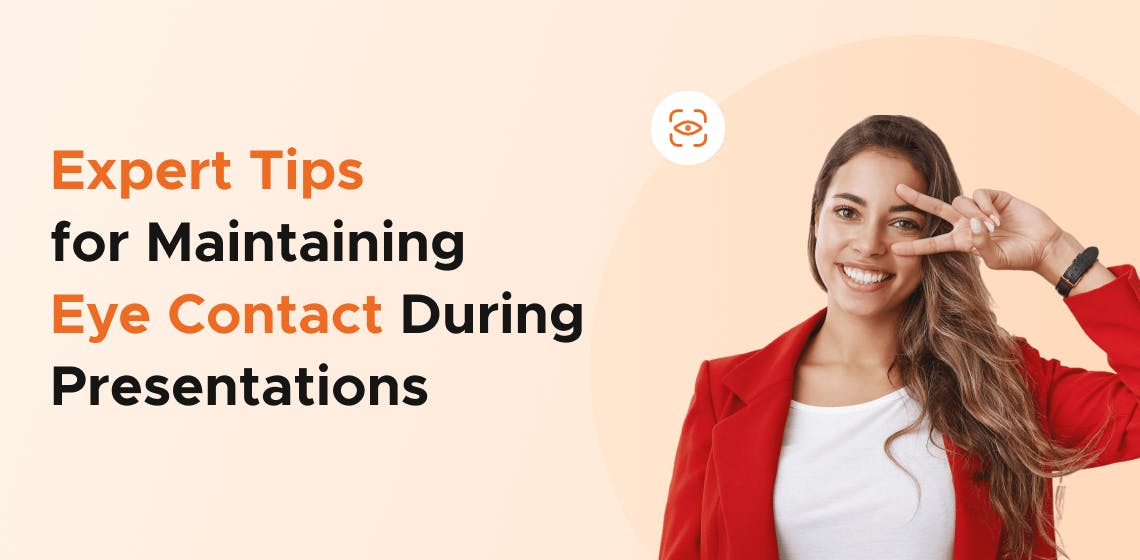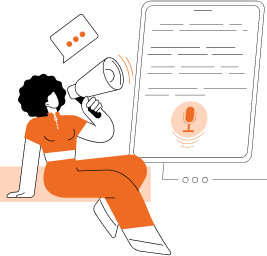
Eyes are the window to the soul.
And while presenting to an audience, they are the window to engagement and influence.
Maintaining eye contact is a powerful way to captivate your audience and ensure your message resonates. Be it a business executive, public speaker, or video content creator, speakers who maintain eye contact are perceived as more confident and credible.
In this blog post, we'll explore the importance of maintaining eye contact while giving presentations, tackle common challenges like dealing with stage fright or large audiences, and share ways of maintaining eye contact during presentations. Additionally, we will discover the numerous benefits of this essential skill and learn how to connect deeply with your audience.
Let us start by understanding why maintaining eye contact is important for effective communication.

Eye contact is a fundamental aspect of communication. It plays an important role in how an audience receives your message. Whether you're delivering a speech, a presentation, or recording a video, maintaining eye contact can significantly improve the effectiveness of your communication. Here’s why it is important:
Making eye contact with your audience establishes a connection that builds trust. It shows you are confident and sincere, making your message more credible. When your audience feels seen and acknowledged, they are likelier to believe and trust what you are saying.
Eye contact keeps your audience engaged. When listeners feel that you are speaking directly to them, they are more likely to pay attention and retain the information you present. Consistent eye contact leads to better audience interaction and response, encouraging active participation and making your presentation more memorable.
Maintaining eye contact conveys confidence and authority. It demonstrates that you are in command of your material and comfortable with your audience. Your audience perceives this confidence positively, making them more receptive to your message.
Eye contact also allows you to gauge audience reactions and adjust your delivery accordingly. By observing your audience's expressions and body language, you can personalize your presentation to meet their needs and interests better, ensuring your message is well-received.
Understanding the importance and benefits of eye contact sets the stage for exploring common challenges speakers face and how to overcome them. Let’s discuss those challenges next.
Maintaining eye contact can be difficult for several reasons. Recognizing these challenges is the first step in overcoming them.
Public speaking can be nerve-wracking, and nervousness can make it difficult to maintain eye contact. Feeling anxious about making mistakes or being judged is common, causing you to avoid looking directly at your audience.
Teleprompters can be a valuable tool for presenters who struggle with maintaining eye contact due to nervousness or distractions. By displaying your script at eye level, teleprompters help keep your gaze steady and focused on the audience.
Among the options available, the FoxCue teleprompter offers an intuitive interface that enhances this experience. With FoxCue, scripts are aligned with the camera lens, allowing you to maintain natural eye contact with your audience while reading your script seamlessly. This connection builds trust and engagement, helping you confidently deliver your message.
Presenting to a large group can make maintaining eye contact with individual audience members challenging. Scanning a large room and connecting with numerous people can be overwhelming. In virtual settings, the physical absence of an audience can make it difficult to know where to look.
Distractions, whether internal (such as wandering thoughts) or external (such as audience movement), can disrupt your focus and break eye contact. Staying present and maintaining a steady gaze can be difficult when multiple distractions exist.
Lack of confidence can also hinder your ability to maintain eye contact. If you are unsure about your material or your speaking abilities, you may find it difficult to look your audience in the eyes.
Cultural norms regarding eye contact vary widely. In some cultures, direct eye contact is considered respectful and engaging; in others, it can be seen as confrontational or rude. Being aware of these cultural differences is important for effective communication.
Overcoming these challenges involves practical techniques and tools, which we will look into next.
Here are some expert tips for maintaining eye contact during presentations, ensuring a confident and engaging delivery.

Preparation is the key to confidence. Practice your speech or presentation multiple times to become familiar with your content. Tools like teleprompters can help you stay on track without constantly looking at your notes. The FoxCue teleprompter app, for instance, allows you to read your script at eye level, helping you maintain natural eye contact with your direct audience.
Identify supportive individuals in the audience and focus on them initially. Their positive feedback can boost your confidence. As you become more comfortable, gradually expand your gaze to include more people, ensuring you make eye contact with various audience members.
Imagine a triangle on each individual's face, with the eyes and mouth forming the three points. Shift your gaze within this triangle to create a natural, engaging eye contact pattern. This technique helps you avoid staring and makes your eye contact feel more dynamic.

Plan natural breaks in your script where you can shift your gaze. This technique helps you avoid staring and creates a more natural flow in your presentation. These breaks can coincide with key points or transitions in your content.
It's okay to break eye contact briefly to look at your notes or visuals. Use these moments to gather your thoughts and reduce nervousness. Be sure to return to eye contact with the audience as quickly as possible to maintain engagement.
Practicing in front of a mirror can help you become more aware of your eye contact patterns. It allows you to see how you appear to your audience and make adjustments to improve your delivery.

Recording your practice sessions with an application like FoxCue can provide valuable feedback. Watch the recordings to see how well you maintain eye contact and identify areas for improvement. This self-assessment can be incredibly beneficial for honing your skills.
To engage a large audience, divide the room into sections and alternate your gaze among them. Spend a few seconds looking at different people in each section. This technique helps create the illusion of eye contact with a larger group and makes everyone feel included.
One effective technique for maintaining eye contact is using apps like FoxCue Teleprompter, which adjusts scrolling speed and pacing to match the presenter’s delivery. This ensures a natural flow of communication without frequent breaks in eye contact.

Before your presentation, visualize your audience and practice making eye contact with them in your mind. This mental rehearsal can reduce anxiety and make you feel more prepared.
A teleprompter can be a game-changer for maintaining eye contact. FoxCue teleprompter app offers features like HD video recording and AI scriptwriting, making delivering and presenting professionally easier. Using a teleprompter, you can focus on connecting with your audience without worrying about losing your place in your script.

Use gestures to complement your eye contact and enhance your message. For instance, as you make eye contact with different sections of the audience, use hand gestures to emphasize key points or guide their attention. This combination makes your presentation more engaging and helps you maintain a natural interaction flow with your audience.
Rather than delivering a monologue, treat your presentation as a dialogue. Pose questions and look at your audience as if expecting an answer. This approach encourages interaction and makes your eye contact feel more natural.
Pay attention to your audience’s reactions and adjust your eye contact accordingly. If you notice someone looking confused or disengaged, make an effort to connect with them and re-engage their interest.
Mindfulness techniques can help you stay present and focused while presenting—practice mindfulness exercises like deep breathing or meditation before speaking to calm your nerves and improve your concentration.

Use eye contact effectively while telling a story. As you narrate different parts of the story, shift your gaze to various audience members to draw them into the narrative. This technique creates a sense of involvement and keeps the audience connected with the unfolding story, making your presentation more immersive and engaging.
Eye contact is not just about looking at your audience—it's about seeing them, understanding their reactions, and adapting your delivery in real-time. Maintaining eye contact builds trust and commands attention, making your message resonate more deeply.
Eye contact has the power to turn passive listeners into active participants. So, as you prepare for your next presentation, think of it as a bridge that connects your words with your audience's hearts and minds.
As you step onto the stage confidently, know that your gaze can light the way to compelling communication.
Thus, speak boldly, connect deeply, and let your eyes lead the way!